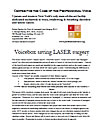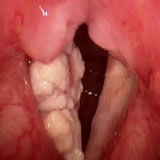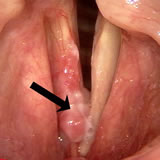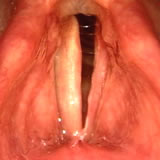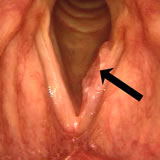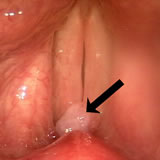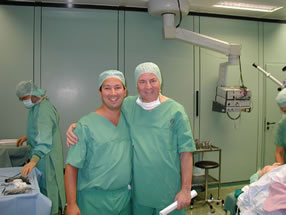
OFFICE HOURS |
OFFICE INFORMATION |
||
|
Monday - Friday |
8:30am - 4:30pm |
980 Westfall Road |
[Phone] 585.442.1110 |
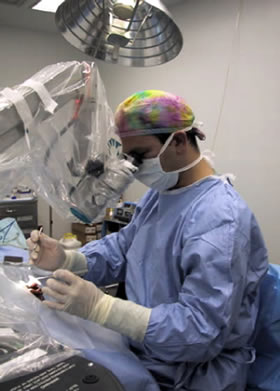 |
I Would Like To: |
Throat Cancer
Larynx Cancer
Voicebox Cancer
Vocal Cord Cancer
Glottic Cancer
Laryngeal Cancer
Head & Neck Cancer
Voicebox saving LASER surgery
The terms "throat cancer", "larynx cancer", "voicebox cancer", "vocal cord cancer" and "laryngeal cancer" are often used interchangeably, and are all types of cancer of the head & neck region. Cancers of the head & neck region are varied and classified by the organ involved, such as the tonsil, tongue or salivary gland; and type of cell from which the cancer grew or arose. Understanding the differences is extremely important because cancers of the different areas may be treated differently, and some are much more serious than others.
Cancers of the "throat" are actually comprised of three distinct regions:
- 1. 'oral pharynx', which includes the tonsils and the back 1/2 of the tongue
- 2. 'hypopharynx', which is where the "throat" divides into a food passage, and
- 3. 'larynx', which is the other 1/2, also known as the "voicebox"
NOTE: Almost everything that follows here deals primarily with cancers of the voicebox = larynx
The larynx (AKA voicebox) contains three parts: the right & left vocal cords (known as the "glottis or glottic" in medical terms), and the areas above the vocal cords (supra-glottic) and below the vocal cords (sub-glottic). Therefore, ALL vocal cord cancers are "laryngeal" (= voicebox) cancers by definition, and the vast majority of laryngeal cancers involve one or both of the vocal cords. A minority of laryngeal cancers involve the areas above or below the vocal cords.
HOARSENESS is the most common complaint that people have when their larynx cancer is first diagnosed, followed by swallowing difficulties, a sense of lump in the throat, or enlarged gland in the neck. ANY current or former smoker with voice changes that are not otherwise explained should be evaluated for throat cancer. Voice changes are an early symptom, the body's way of telling you that something is wrong. Almost any disease will be much easier to treat and cure if diagnosed early, when the tumor is smaller. Hoarseness in current or former smokers should never be ignored.
Smoking. The vocal cords are actually a valve that sit on the top of the windpipe, and are the narrowest part of the airway. As such, any smoke inhaled impact the vocal cords on the way into the lungs, and AGAIN on the way out when you exhale. This is why the vocal cord(s) are one of the most vulnerable areas to smoker's cancers, as are the lungs.
Drinking. Excessive alcohol is thought to be the cause of several serious cancers, especially esophageal (swallowing tube). Drinking excessive alcohol also multiplies the harmful effects of smoking.
HPV/ voicebox papillomas AKA voicebox warts. These papillomas of the vocal cords may be pre-cancerous. Patients with laryngeal papillomas should have "viral typing" done on a biopsy of the papilloma to see if it contains a HPV virus that is high-risk or low-risk for cancer development. See the page on "HPV/ papilloma information" for more details.
Uncontrolled reflux disease is more of a risk factor for esophageal (swallowing tube) cancers but does play a role in larynx cancer. All patients treated for throat cancer should be on daily reflux medication.
Genetics is one of the main reasons why someone develops cancer while someone else who smokes the same number of cigarettes for the same number of years does not. You can not control your genetic predisposition for diseases including cancer, but you certainly can control your habits (smoking, drinking), and general well being. General health plays a critical role in the immune system … the main defense against cancer development.
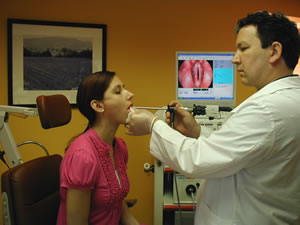 The terms "tumor", "mass" and "neoplasm" simply means 'growth.' Tumors may be benign or malignant (= cancer). Only a biopsy of the tumor can determine whether the mass is cancerous or not. The majority of patients with hoarseness are examined in the clinic with a small, painless telescope that only goes into mouth, but can look down the entire throat. This method of examining the voicebox is only available in specialized clinics.
The terms "tumor", "mass" and "neoplasm" simply means 'growth.' Tumors may be benign or malignant (= cancer). Only a biopsy of the tumor can determine whether the mass is cancerous or not. The majority of patients with hoarseness are examined in the clinic with a small, painless telescope that only goes into mouth, but can look down the entire throat. This method of examining the voicebox is only available in specialized clinics.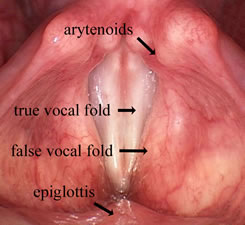
This is what a normal larynx looks like when examined in the office. The normal anatomy is illustrated.
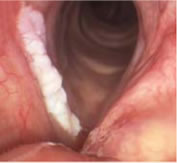 If a tumor is noted, such as the white "mass" in the photograph, a biopsy is generally recommended. In most centers across the United States, this biopsy is performed under general anesthesia in an operating room. There are some highly dedicated centers specializing in larynx cancer that can perform the biopsy in the office under topical anesthesia. This has the advantages of avoiding a trip to the operating room, waiting for the biopsy, and getting the results much sooner (typically weeks earlier).
If a tumor is noted, such as the white "mass" in the photograph, a biopsy is generally recommended. In most centers across the United States, this biopsy is performed under general anesthesia in an operating room. There are some highly dedicated centers specializing in larynx cancer that can perform the biopsy in the office under topical anesthesia. This has the advantages of avoiding a trip to the operating room, waiting for the biopsy, and getting the results much sooner (typically weeks earlier).
If the biopsy demonstrates cancer cells, you will be assigned a "Cancer Stage." A cancer stage is a uniform way of categorizing the cancer in terms of the area(s) involved, how deeply it has invaded and to what extent it has spread to the local lymph glands or beyond. The stage is determined by the examination, and will frequently involve CAT/ PET/ MRI scans of the neck and chest region. Cancer specialists use the "TNM" classification to assign the stage, where the "T" (Tumor) is for the size or areas involved by the main cancer mass, "N" (Nodes) is for the presence of lymph node(s) involved, if any, and "M" (Metastasis) is for the presence of any 'satellites' of cancer spread to the lungs or elsewhere. There are four stages. Stage 1 is the earliest and has the highest cure rates. Stage 4 is the most advanced, and intuitively has lower relative cure rates.
99%+ of larynx cancers arise from a "squamous cell" and are therefore termed "squamous cell carcinomas." Not all "squamous cell carcinomas" are identical when examined under a microscope by the pathologist. You may also hear about tumor "grade." Grading a tumor is a way of predicting its aggressiveness. The higher the grade, the more aggressive a tumor is expected to behave. The pathologist looking at the biopsy will assign a "grade" to the cancer that is either "well-differentiated" (= low grade), "moderately differentiated" (=medium grade), or "poorly differentiated" (=highest grade). Stage + Tumor Grade are used to decide which treatment(s) are recommended. Other factors include the overall health of the patient, as well as the patient's wishes and preferences.
Treatment options will be based primarily on the stage of the cancer, but strongly influenced by the availability of certain procedures (just like the office-based biopsy described above), as well as the experiences and preferences of the physician who made the diagnosis. There are a few general rules of thumb:
Stage 1 & 2 cancers (termed 'early stage) can be treated with a single modality of therapy.
Stage 3 & 4 cancers (termed 'late or advanced' stage) may require multiple modalities of treatment.
High Grade tumors require more treatment than low & medium grade tumors.
There are two broad modalities of treatment: surgical and non-surgical. Non-surgical treatment is radiation therapy by and large, sometimes with added chemotherapy. Chemotherapy is NOT a standard first line (single modality) treatment option for squamous cell carcinomas of the larynx. Chemotherapy in these cancers is most commonly used to make the cancerous cells more responsive to the radiation in cancers assigned a stage of 3 or 4.
For stage 1 or 2 cancers, the vast majority of large and small center across North America would use radiation therapy alone as a 'single modality' treatment with a 80-95+% cure rate. Those patients who fail to be cured with the radiation therapy would require a surgical procedure to remove the entire voicebox, a surgery call total laryngectomy. There are roughly 20 centers scattered across the United States that offer LASER ENDOSCOPIC LARYNX-PRESERVING MICROSURGERY (sometimes termed Trans-Oral Laser Surgery in the medical literature) to remove only the cancer through the mouth and preserve the rest of the voicebox. There are clear advantages of this Laser Surgery over radiation therapy for patients who are fortunate enough to have this procedure offered in their region. Comparing the pros and cons of laser surgery versus standard radiation therapy:
Cure rates: Both LASER surgery and radiation therapy have high cure rates, roughly 80-96% depending on certain factors. The laser surgery is a 2-6 hour operation and a one-day overnight hospitalization. The radiation therapy is 5 days a week for 6 weeks.
Recurrence: radiation therapy can only be given once. If the cancer recurs or is not eradicated, the voicebox is almost always removed. The LASER surgery can be repeated if necessary. In the rare patient where the LASER surgery does not cure the cancer, radiation therapy can still be used effectively, and provides a layer of protection against having to have the entire voicebox removed. The other pro of the LASER surgery is that the pathologist looks at the cancer after it has been removed and can confirm the that it has been removed in its entirety. With radiation therapy, no such confirmation is possible without a trip to the operating room with a second biopsy.
A con of LASER surgery is that only a small number of centers exist with the expertise and experience to treat these difficult cancers. Radiation therapy is widely available in almost all communities in North America.
The surgery occurs under general anesthesia in the main operating room of a hospital. Once the patient is asleep, a laryngoscope is placed into the mouth until the surgeon can see the throat and cancer (left picture). 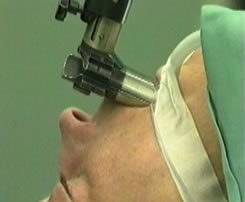
A microscope is then used so that only the minimal amount of uninvolved areas is removed. Two types are lasers are used, a CO2 (carbon dioxide) and KTP. The laser is attached to the microscope and directed down the scope at the cancer (right picture). The cancerous tumor is completely removed (NOT vaporized). This can take from 45 minutes to 6 hours depending on the size and extent of the cancer. The tumor is examined by a pathologist who can confirm that the entire cancer has been removed. This is the "confirmation of cancer eradication" described above, an important advantage of the surgery over standard radiation therapy as far as the patient's peace of mind. The patient is awoken and typically spends the night in the hospital for observation. There is not a significant amount of post-operative pain. Post-operative restrictions (such as resting the voice) may be imposed, and differ from case to case. Once the cancer has been confirmed as being eradicated, the treatment is done! There is usually no reason for any additional therapy. Patients then begin "cancer surveillance" every two months for the first two years to make certain that nothing recurs, which involves an examination in the office identical to the one that discovered the cancer (described above).
Examples
Pre-operative view of cancer Post-operative view at 2 months Links http://www.cancer.gov/cancertopics/types/throat This links to the National Institutes of Health/ National Cancer Institute's information on throat cancer, with links to treatment, causes and other information.
http://www.cancer.gov/cancertopics/pdq/treatment/laryngeal/Patient This also links to the NIH/NCI with information specific for LARYNX cancer, with specific treatment options listed here:
http://www.cancer.gov/cancertopics/pdq/treatment/laryngeal/Patient/page4
Statistics regarding larynx cancer mayt be found here: http://seer.cancer.gov/statfacts/html/laryn.html
Acknowledgements Dr. Michael Haben operating with his mentor (retired) Professor Wolfgang Steiner of Gottingen Germany, considered by most as the Father of Trans-Oral LASER surgery.
